Analysis of Apero Restaurant's Hospitality Management in New Zealand
VerifiedAdded on 2022/10/12
|20
|5846
|154
Report
AI Summary
This report provides a comprehensive analysis of the hospitality management practices at Apero, a highly-regarded restaurant located in Auckland, New Zealand. The executive summary highlights Apero's focus on customer satisfaction, effective operations, and its ranking within the top 50 restaurants in New Zealand. The report delves into the restaurant's modern ambiance, its use of gastronomy to enhance the dining experience through food and wine pairings, and its menu development. It explores the aspects of New Zealand cuisine and the wine industry, as well as the meal experience, including customer needs like appreciation, physiological, social, economic, and psychological needs. The literature review provides background on gastronomy, including practical, theoretical, and technical aspects. The report concludes with recommendations for Apero to expand its menu and emphasize locally sourced ingredients and sustainable practices. The report is based on the assessment brief for the Graduate Diploma in Applied Management (Level 7) New Zealand Hospitality Management Course, DAM793.
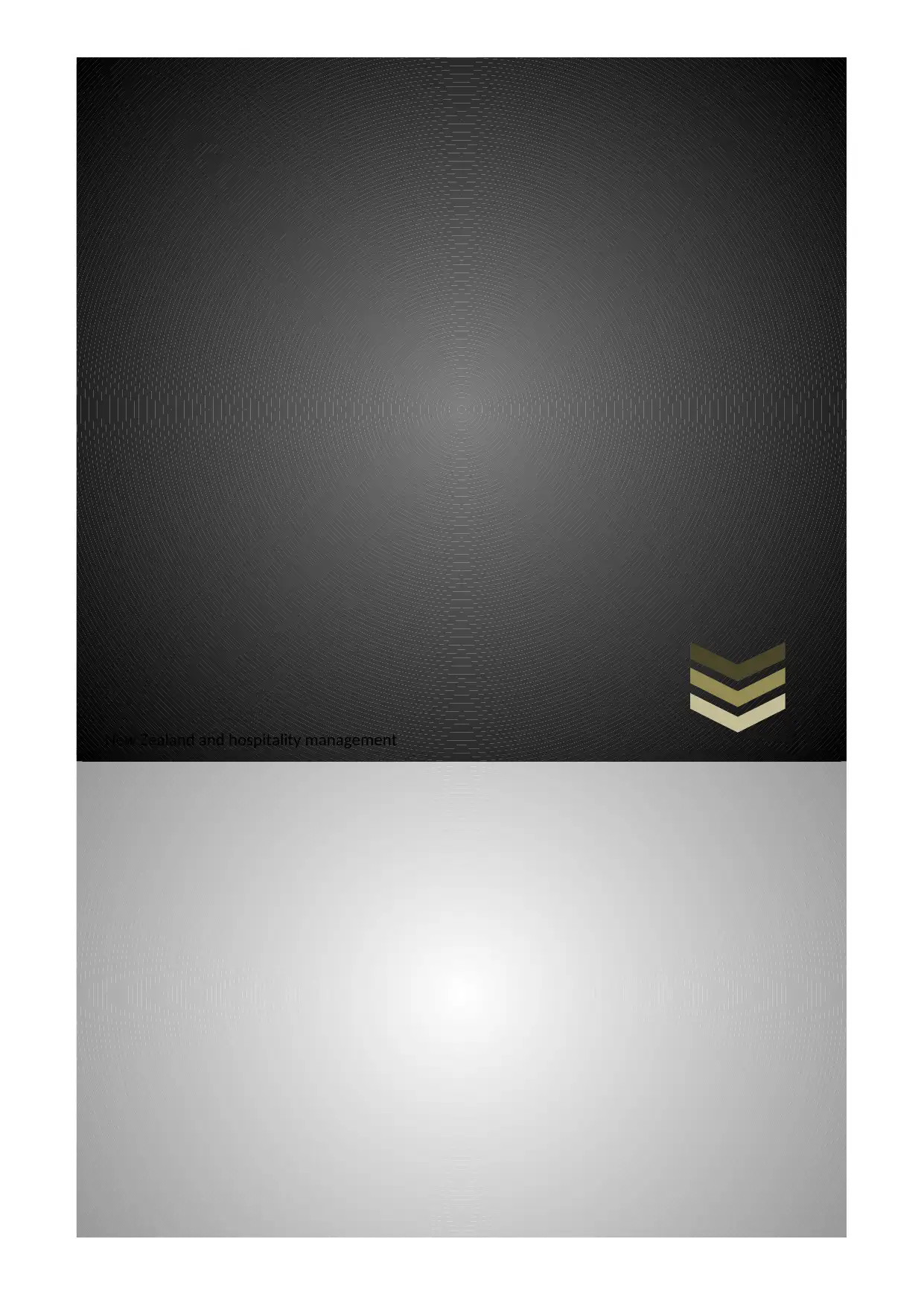
New Zealand and hospitality management
Paraphrase This Document
Need a fresh take? Get an instant paraphrase of this document with our AI Paraphraser
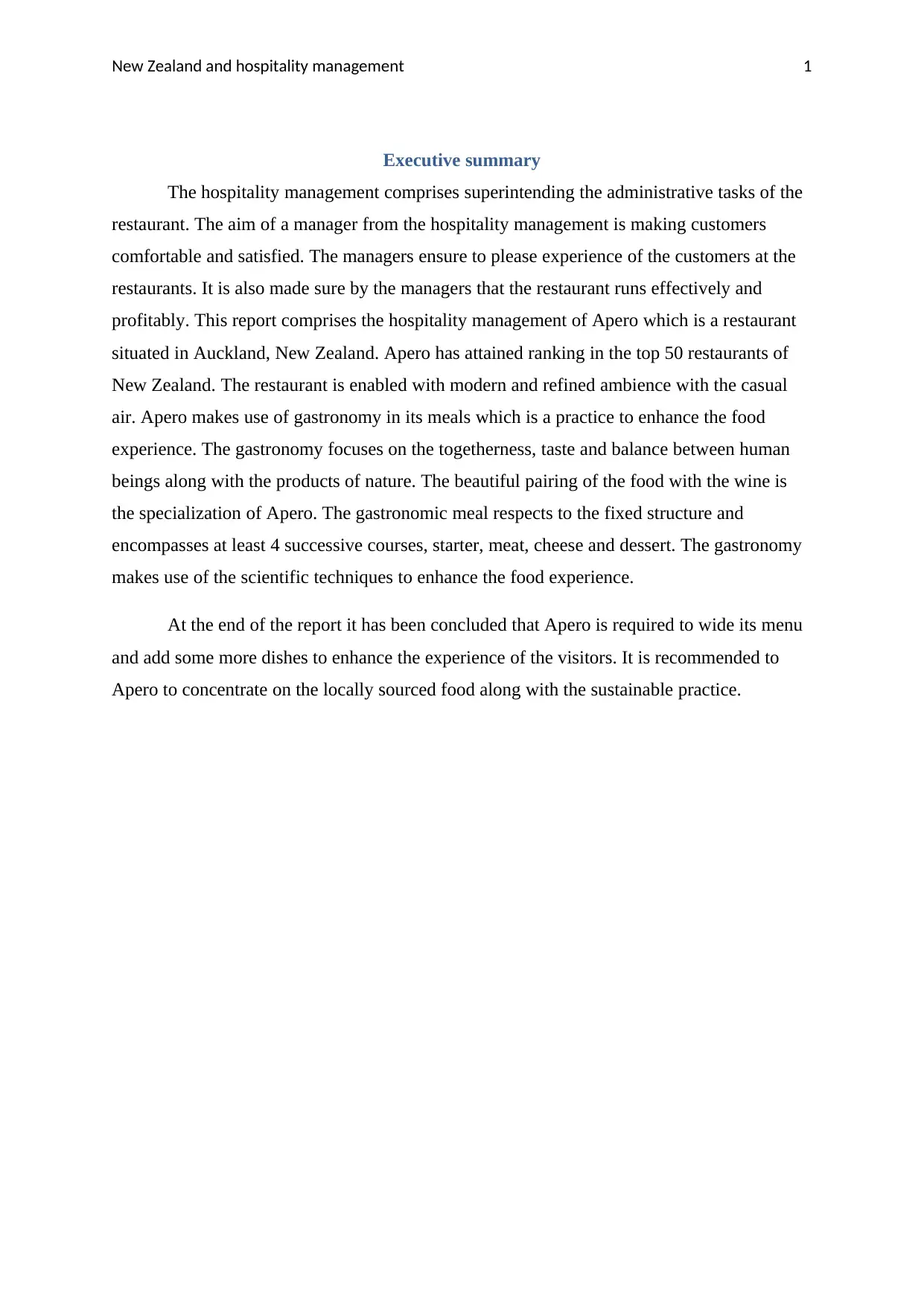
New Zealand and hospitality management 1
Executive summary
The hospitality management comprises superintending the administrative tasks of the
restaurant. The aim of a manager from the hospitality management is making customers
comfortable and satisfied. The managers ensure to please experience of the customers at the
restaurants. It is also made sure by the managers that the restaurant runs effectively and
profitably. This report comprises the hospitality management of Apero which is a restaurant
situated in Auckland, New Zealand. Apero has attained ranking in the top 50 restaurants of
New Zealand. The restaurant is enabled with modern and refined ambience with the casual
air. Apero makes use of gastronomy in its meals which is a practice to enhance the food
experience. The gastronomy focuses on the togetherness, taste and balance between human
beings along with the products of nature. The beautiful pairing of the food with the wine is
the specialization of Apero. The gastronomic meal respects to the fixed structure and
encompasses at least 4 successive courses, starter, meat, cheese and dessert. The gastronomy
makes use of the scientific techniques to enhance the food experience.
At the end of the report it has been concluded that Apero is required to wide its menu
and add some more dishes to enhance the experience of the visitors. It is recommended to
Apero to concentrate on the locally sourced food along with the sustainable practice.
Executive summary
The hospitality management comprises superintending the administrative tasks of the
restaurant. The aim of a manager from the hospitality management is making customers
comfortable and satisfied. The managers ensure to please experience of the customers at the
restaurants. It is also made sure by the managers that the restaurant runs effectively and
profitably. This report comprises the hospitality management of Apero which is a restaurant
situated in Auckland, New Zealand. Apero has attained ranking in the top 50 restaurants of
New Zealand. The restaurant is enabled with modern and refined ambience with the casual
air. Apero makes use of gastronomy in its meals which is a practice to enhance the food
experience. The gastronomy focuses on the togetherness, taste and balance between human
beings along with the products of nature. The beautiful pairing of the food with the wine is
the specialization of Apero. The gastronomic meal respects to the fixed structure and
encompasses at least 4 successive courses, starter, meat, cheese and dessert. The gastronomy
makes use of the scientific techniques to enhance the food experience.
At the end of the report it has been concluded that Apero is required to wide its menu
and add some more dishes to enhance the experience of the visitors. It is recommended to
Apero to concentrate on the locally sourced food along with the sustainable practice.
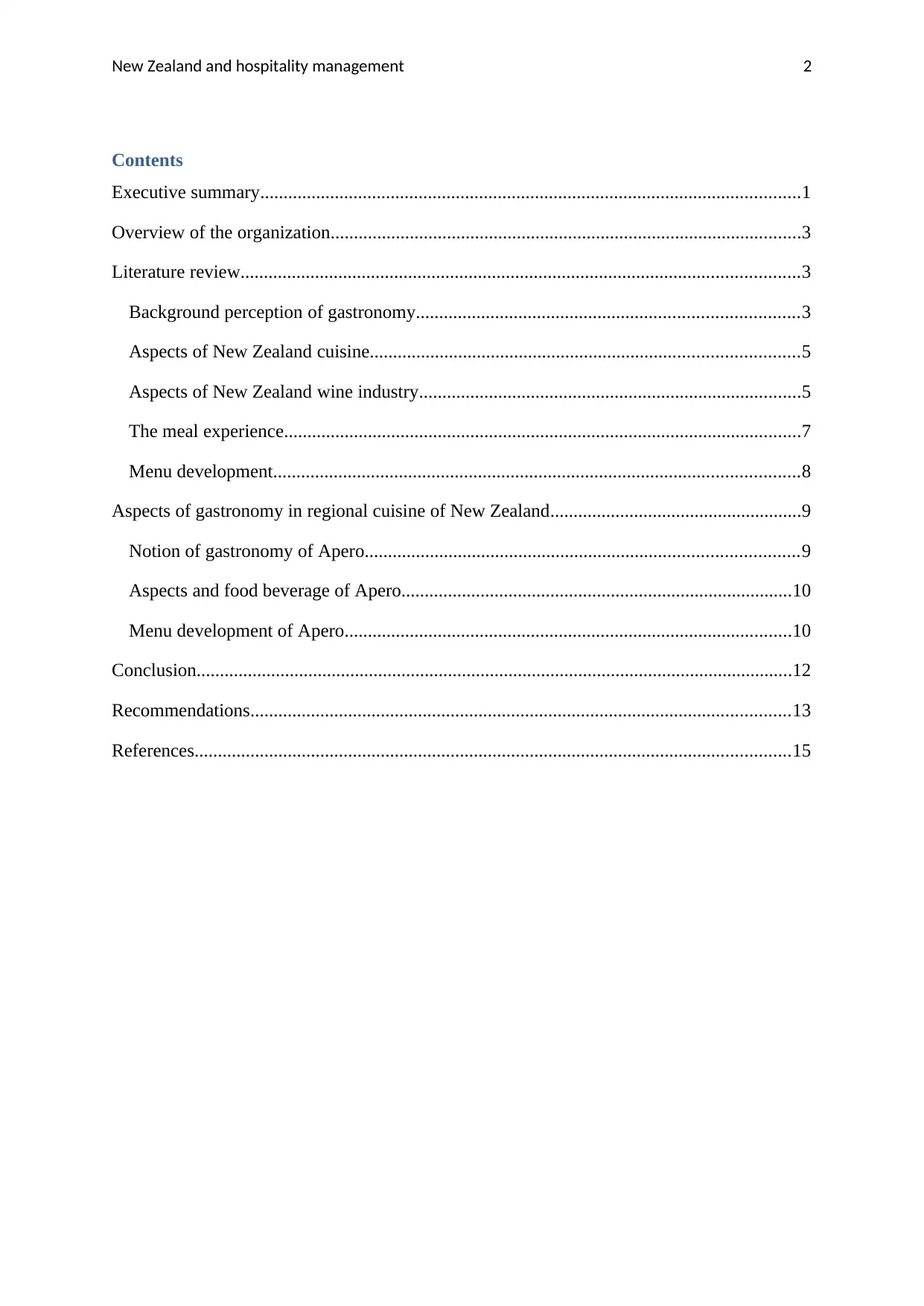
New Zealand and hospitality management 2
Contents
Executive summary....................................................................................................................1
Overview of the organization.....................................................................................................3
Literature review........................................................................................................................3
Background perception of gastronomy..................................................................................3
Aspects of New Zealand cuisine............................................................................................5
Aspects of New Zealand wine industry..................................................................................5
The meal experience...............................................................................................................7
Menu development.................................................................................................................8
Aspects of gastronomy in regional cuisine of New Zealand......................................................9
Notion of gastronomy of Apero.............................................................................................9
Aspects and food beverage of Apero....................................................................................10
Menu development of Apero................................................................................................10
Conclusion................................................................................................................................12
Recommendations....................................................................................................................13
References................................................................................................................................15
Contents
Executive summary....................................................................................................................1
Overview of the organization.....................................................................................................3
Literature review........................................................................................................................3
Background perception of gastronomy..................................................................................3
Aspects of New Zealand cuisine............................................................................................5
Aspects of New Zealand wine industry..................................................................................5
The meal experience...............................................................................................................7
Menu development.................................................................................................................8
Aspects of gastronomy in regional cuisine of New Zealand......................................................9
Notion of gastronomy of Apero.............................................................................................9
Aspects and food beverage of Apero....................................................................................10
Menu development of Apero................................................................................................10
Conclusion................................................................................................................................12
Recommendations....................................................................................................................13
References................................................................................................................................15
⊘ This is a preview!⊘
Do you want full access?
Subscribe today to unlock all pages.

Trusted by 1+ million students worldwide
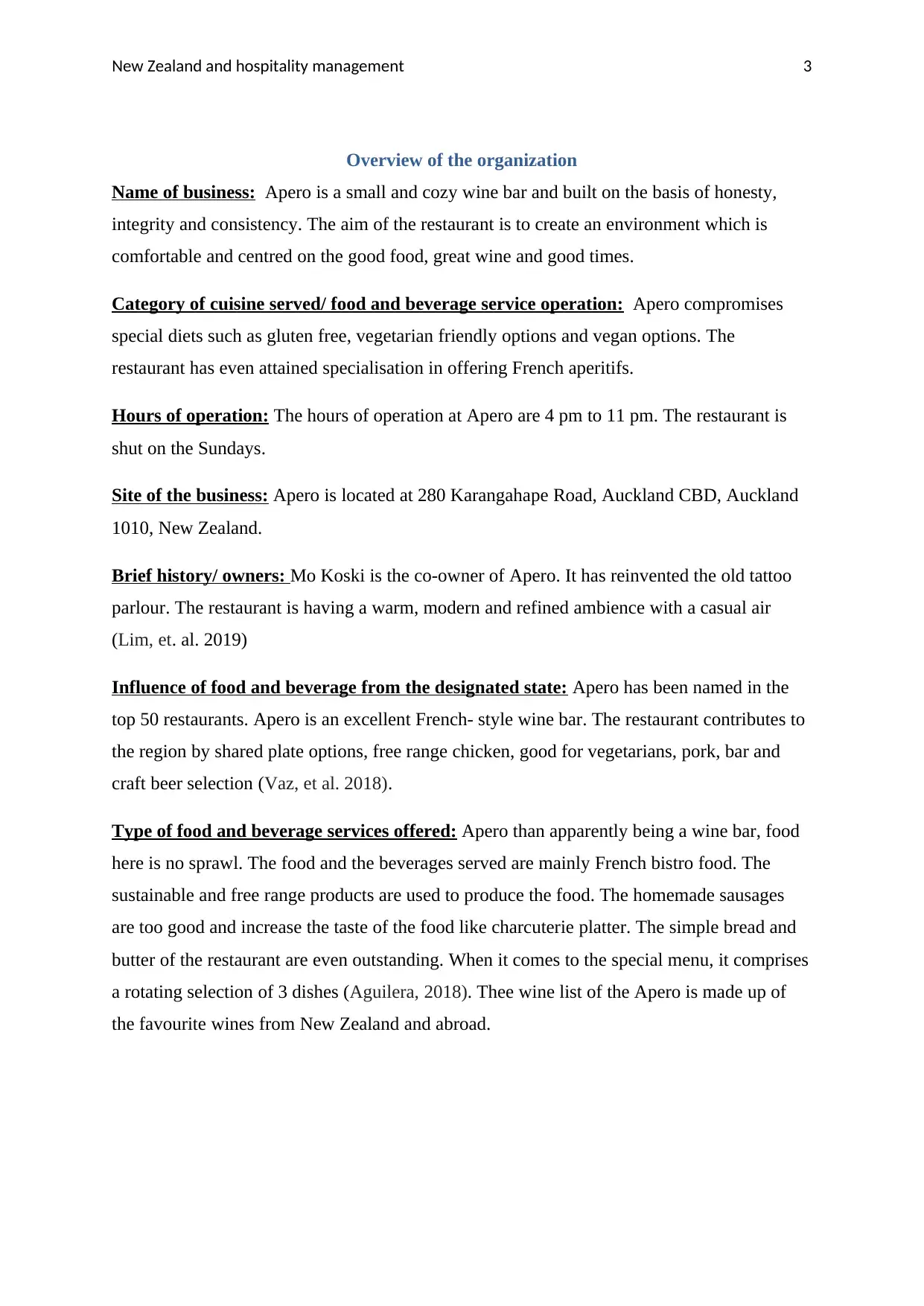
New Zealand and hospitality management 3
Overview of the organization
Name of business: Apero is a small and cozy wine bar and built on the basis of honesty,
integrity and consistency. The aim of the restaurant is to create an environment which is
comfortable and centred on the good food, great wine and good times.
Category of cuisine served/ food and beverage service operation: Apero compromises
special diets such as gluten free, vegetarian friendly options and vegan options. The
restaurant has even attained specialisation in offering French aperitifs.
Hours of operation: The hours of operation at Apero are 4 pm to 11 pm. The restaurant is
shut on the Sundays.
Site of the business: Apero is located at 280 Karangahape Road, Auckland CBD, Auckland
1010, New Zealand.
Brief history/ owners: Mo Koski is the co-owner of Apero. It has reinvented the old tattoo
parlour. The restaurant is having a warm, modern and refined ambience with a casual air
(Lim, et. al. 2019)
Influence of food and beverage from the designated state: Apero has been named in the
top 50 restaurants. Apero is an excellent French- style wine bar. The restaurant contributes to
the region by shared plate options, free range chicken, good for vegetarians, pork, bar and
craft beer selection (Vaz, et al. 2018).
Type of food and beverage services offered: Apero than apparently being a wine bar, food
here is no sprawl. The food and the beverages served are mainly French bistro food. The
sustainable and free range products are used to produce the food. The homemade sausages
are too good and increase the taste of the food like charcuterie platter. The simple bread and
butter of the restaurant are even outstanding. When it comes to the special menu, it comprises
a rotating selection of 3 dishes (Aguilera, 2018). Thee wine list of the Apero is made up of
the favourite wines from New Zealand and abroad.
Overview of the organization
Name of business: Apero is a small and cozy wine bar and built on the basis of honesty,
integrity and consistency. The aim of the restaurant is to create an environment which is
comfortable and centred on the good food, great wine and good times.
Category of cuisine served/ food and beverage service operation: Apero compromises
special diets such as gluten free, vegetarian friendly options and vegan options. The
restaurant has even attained specialisation in offering French aperitifs.
Hours of operation: The hours of operation at Apero are 4 pm to 11 pm. The restaurant is
shut on the Sundays.
Site of the business: Apero is located at 280 Karangahape Road, Auckland CBD, Auckland
1010, New Zealand.
Brief history/ owners: Mo Koski is the co-owner of Apero. It has reinvented the old tattoo
parlour. The restaurant is having a warm, modern and refined ambience with a casual air
(Lim, et. al. 2019)
Influence of food and beverage from the designated state: Apero has been named in the
top 50 restaurants. Apero is an excellent French- style wine bar. The restaurant contributes to
the region by shared plate options, free range chicken, good for vegetarians, pork, bar and
craft beer selection (Vaz, et al. 2018).
Type of food and beverage services offered: Apero than apparently being a wine bar, food
here is no sprawl. The food and the beverages served are mainly French bistro food. The
sustainable and free range products are used to produce the food. The homemade sausages
are too good and increase the taste of the food like charcuterie platter. The simple bread and
butter of the restaurant are even outstanding. When it comes to the special menu, it comprises
a rotating selection of 3 dishes (Aguilera, 2018). Thee wine list of the Apero is made up of
the favourite wines from New Zealand and abroad.
Paraphrase This Document
Need a fresh take? Get an instant paraphrase of this document with our AI Paraphraser
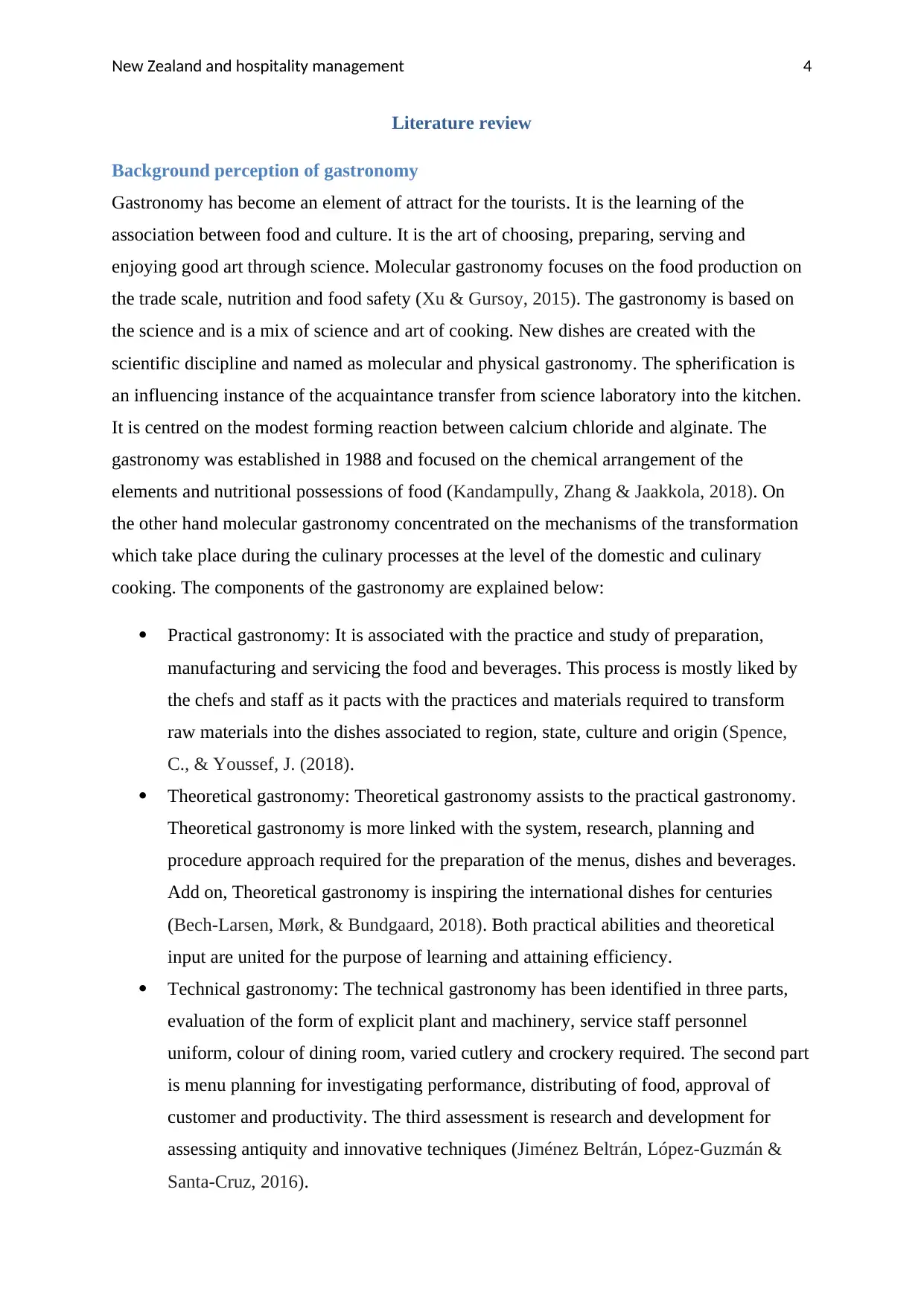
New Zealand and hospitality management 4
Literature review
Background perception of gastronomy
Gastronomy has become an element of attract for the tourists. It is the learning of the
association between food and culture. It is the art of choosing, preparing, serving and
enjoying good art through science. Molecular gastronomy focuses on the food production on
the trade scale, nutrition and food safety (Xu & Gursoy, 2015). The gastronomy is based on
the science and is a mix of science and art of cooking. New dishes are created with the
scientific discipline and named as molecular and physical gastronomy. The spherification is
an influencing instance of the acquaintance transfer from science laboratory into the kitchen.
It is centred on the modest forming reaction between calcium chloride and alginate. The
gastronomy was established in 1988 and focused on the chemical arrangement of the
elements and nutritional possessions of food (Kandampully, Zhang & Jaakkola, 2018). On
the other hand molecular gastronomy concentrated on the mechanisms of the transformation
which take place during the culinary processes at the level of the domestic and culinary
cooking. The components of the gastronomy are explained below:
Practical gastronomy: It is associated with the practice and study of preparation,
manufacturing and servicing the food and beverages. This process is mostly liked by
the chefs and staff as it pacts with the practices and materials required to transform
raw materials into the dishes associated to region, state, culture and origin (Spence,
C., & Youssef, J. (2018).
Theoretical gastronomy: Theoretical gastronomy assists to the practical gastronomy.
Theoretical gastronomy is more linked with the system, research, planning and
procedure approach required for the preparation of the menus, dishes and beverages.
Add on, Theoretical gastronomy is inspiring the international dishes for centuries
(Bech-Larsen, Mørk, & Bundgaard, 2018). Both practical abilities and theoretical
input are united for the purpose of learning and attaining efficiency.
Technical gastronomy: The technical gastronomy has been identified in three parts,
evaluation of the form of explicit plant and machinery, service staff personnel
uniform, colour of dining room, varied cutlery and crockery required. The second part
is menu planning for investigating performance, distributing of food, approval of
customer and productivity. The third assessment is research and development for
assessing antiquity and innovative techniques (Jiménez Beltrán, López-Guzmán &
Santa-Cruz, 2016).
Literature review
Background perception of gastronomy
Gastronomy has become an element of attract for the tourists. It is the learning of the
association between food and culture. It is the art of choosing, preparing, serving and
enjoying good art through science. Molecular gastronomy focuses on the food production on
the trade scale, nutrition and food safety (Xu & Gursoy, 2015). The gastronomy is based on
the science and is a mix of science and art of cooking. New dishes are created with the
scientific discipline and named as molecular and physical gastronomy. The spherification is
an influencing instance of the acquaintance transfer from science laboratory into the kitchen.
It is centred on the modest forming reaction between calcium chloride and alginate. The
gastronomy was established in 1988 and focused on the chemical arrangement of the
elements and nutritional possessions of food (Kandampully, Zhang & Jaakkola, 2018). On
the other hand molecular gastronomy concentrated on the mechanisms of the transformation
which take place during the culinary processes at the level of the domestic and culinary
cooking. The components of the gastronomy are explained below:
Practical gastronomy: It is associated with the practice and study of preparation,
manufacturing and servicing the food and beverages. This process is mostly liked by
the chefs and staff as it pacts with the practices and materials required to transform
raw materials into the dishes associated to region, state, culture and origin (Spence,
C., & Youssef, J. (2018).
Theoretical gastronomy: Theoretical gastronomy assists to the practical gastronomy.
Theoretical gastronomy is more linked with the system, research, planning and
procedure approach required for the preparation of the menus, dishes and beverages.
Add on, Theoretical gastronomy is inspiring the international dishes for centuries
(Bech-Larsen, Mørk, & Bundgaard, 2018). Both practical abilities and theoretical
input are united for the purpose of learning and attaining efficiency.
Technical gastronomy: The technical gastronomy has been identified in three parts,
evaluation of the form of explicit plant and machinery, service staff personnel
uniform, colour of dining room, varied cutlery and crockery required. The second part
is menu planning for investigating performance, distributing of food, approval of
customer and productivity. The third assessment is research and development for
assessing antiquity and innovative techniques (Jiménez Beltrán, López-Guzmán &
Santa-Cruz, 2016).
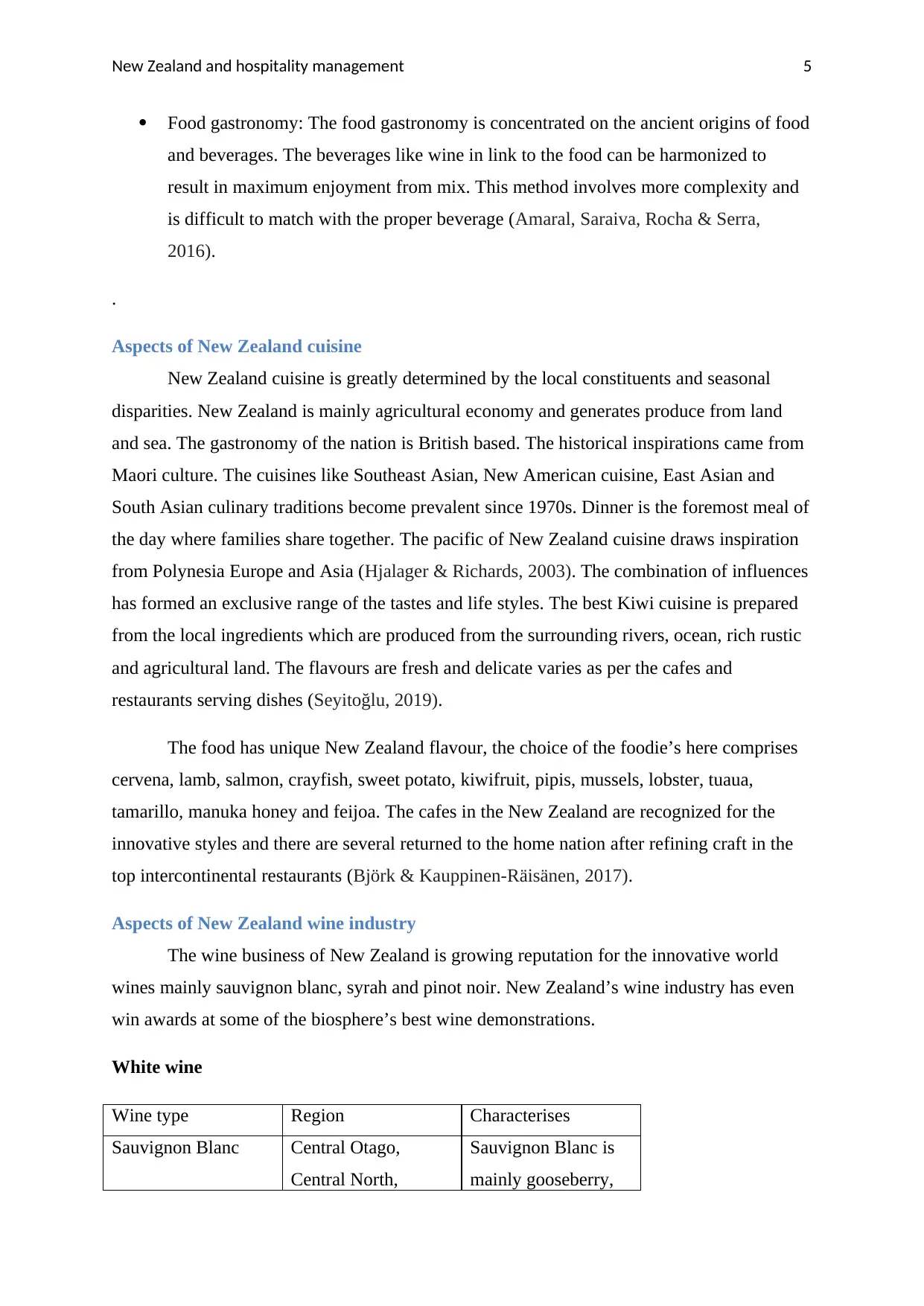
New Zealand and hospitality management 5
Food gastronomy: The food gastronomy is concentrated on the ancient origins of food
and beverages. The beverages like wine in link to the food can be harmonized to
result in maximum enjoyment from mix. This method involves more complexity and
is difficult to match with the proper beverage (Amaral, Saraiva, Rocha & Serra,
2016).
.
Aspects of New Zealand cuisine
New Zealand cuisine is greatly determined by the local constituents and seasonal
disparities. New Zealand is mainly agricultural economy and generates produce from land
and sea. The gastronomy of the nation is British based. The historical inspirations came from
Maori culture. The cuisines like Southeast Asian, New American cuisine, East Asian and
South Asian culinary traditions become prevalent since 1970s. Dinner is the foremost meal of
the day where families share together. The pacific of New Zealand cuisine draws inspiration
from Polynesia Europe and Asia (Hjalager & Richards, 2003). The combination of influences
has formed an exclusive range of the tastes and life styles. The best Kiwi cuisine is prepared
from the local ingredients which are produced from the surrounding rivers, ocean, rich rustic
and agricultural land. The flavours are fresh and delicate varies as per the cafes and
restaurants serving dishes (Seyitoğlu, 2019).
The food has unique New Zealand flavour, the choice of the foodie’s here comprises
cervena, lamb, salmon, crayfish, sweet potato, kiwifruit, pipis, mussels, lobster, tuaua,
tamarillo, manuka honey and feijoa. The cafes in the New Zealand are recognized for the
innovative styles and there are several returned to the home nation after refining craft in the
top intercontinental restaurants (Björk & Kauppinen-Räisänen, 2017).
Aspects of New Zealand wine industry
The wine business of New Zealand is growing reputation for the innovative world
wines mainly sauvignon blanc, syrah and pinot noir. New Zealand’s wine industry has even
win awards at some of the biosphere’s best wine demonstrations.
White wine
Wine type Region Characterises
Sauvignon Blanc Central Otago,
Central North,
Sauvignon Blanc is
mainly gooseberry,
Food gastronomy: The food gastronomy is concentrated on the ancient origins of food
and beverages. The beverages like wine in link to the food can be harmonized to
result in maximum enjoyment from mix. This method involves more complexity and
is difficult to match with the proper beverage (Amaral, Saraiva, Rocha & Serra,
2016).
.
Aspects of New Zealand cuisine
New Zealand cuisine is greatly determined by the local constituents and seasonal
disparities. New Zealand is mainly agricultural economy and generates produce from land
and sea. The gastronomy of the nation is British based. The historical inspirations came from
Maori culture. The cuisines like Southeast Asian, New American cuisine, East Asian and
South Asian culinary traditions become prevalent since 1970s. Dinner is the foremost meal of
the day where families share together. The pacific of New Zealand cuisine draws inspiration
from Polynesia Europe and Asia (Hjalager & Richards, 2003). The combination of influences
has formed an exclusive range of the tastes and life styles. The best Kiwi cuisine is prepared
from the local ingredients which are produced from the surrounding rivers, ocean, rich rustic
and agricultural land. The flavours are fresh and delicate varies as per the cafes and
restaurants serving dishes (Seyitoğlu, 2019).
The food has unique New Zealand flavour, the choice of the foodie’s here comprises
cervena, lamb, salmon, crayfish, sweet potato, kiwifruit, pipis, mussels, lobster, tuaua,
tamarillo, manuka honey and feijoa. The cafes in the New Zealand are recognized for the
innovative styles and there are several returned to the home nation after refining craft in the
top intercontinental restaurants (Björk & Kauppinen-Räisänen, 2017).
Aspects of New Zealand wine industry
The wine business of New Zealand is growing reputation for the innovative world
wines mainly sauvignon blanc, syrah and pinot noir. New Zealand’s wine industry has even
win awards at some of the biosphere’s best wine demonstrations.
White wine
Wine type Region Characterises
Sauvignon Blanc Central Otago,
Central North,
Sauvignon Blanc is
mainly gooseberry,
⊘ This is a preview!⊘
Do you want full access?
Subscribe today to unlock all pages.

Trusted by 1+ million students worldwide
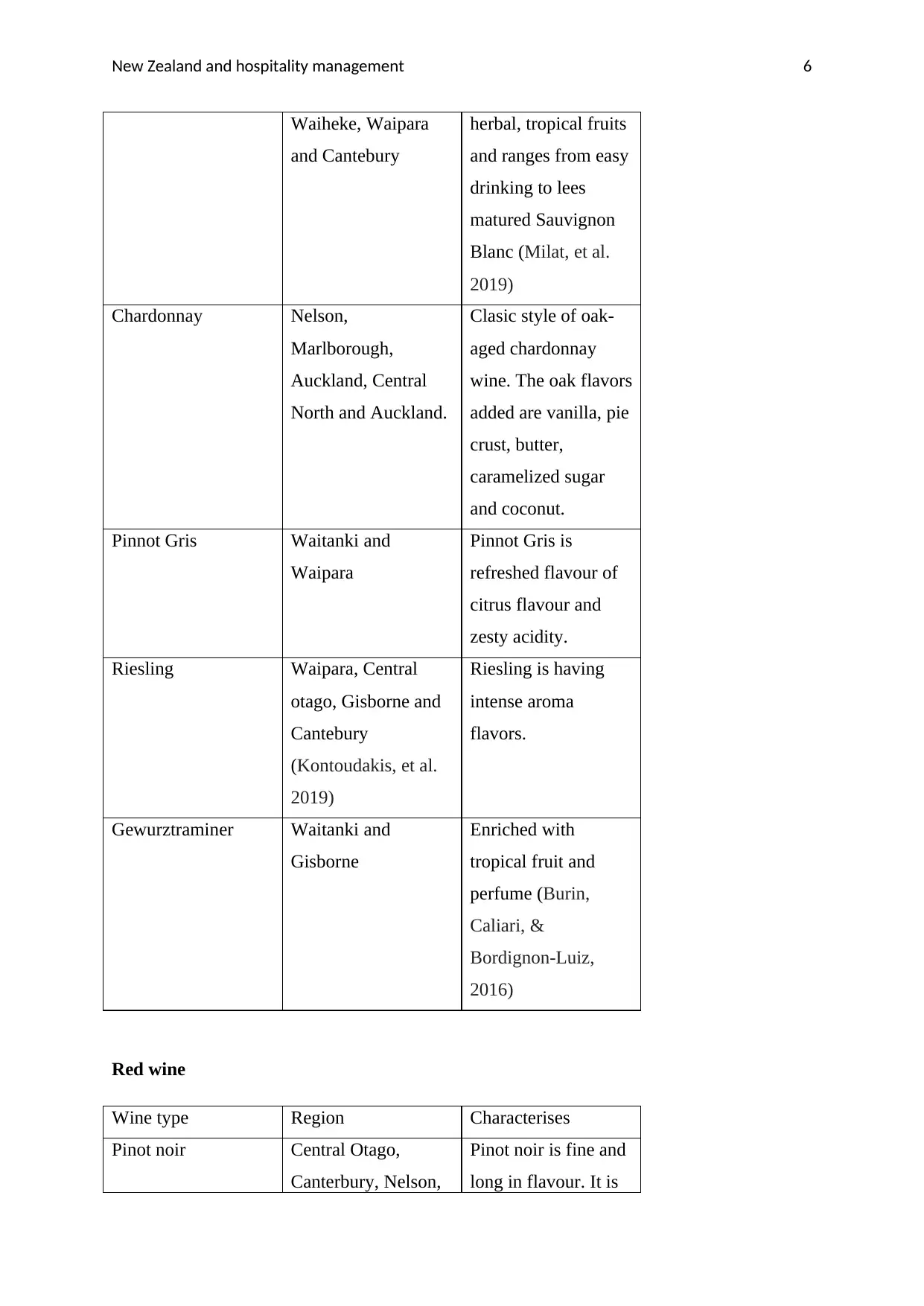
New Zealand and hospitality management 6
Waiheke, Waipara
and Cantebury
herbal, tropical fruits
and ranges from easy
drinking to lees
matured Sauvignon
Blanc (Milat, et al.
2019)
Chardonnay Nelson,
Marlborough,
Auckland, Central
North and Auckland.
Clasic style of oak-
aged chardonnay
wine. The oak flavors
added are vanilla, pie
crust, butter,
caramelized sugar
and coconut.
Pinnot Gris Waitanki and
Waipara
Pinnot Gris is
refreshed flavour of
citrus flavour and
zesty acidity.
Riesling Waipara, Central
otago, Gisborne and
Cantebury
(Kontoudakis, et al.
2019)
Riesling is having
intense aroma
flavors.
Gewurztraminer Waitanki and
Gisborne
Enriched with
tropical fruit and
perfume (Burin,
Caliari, &
Bordignon-Luiz,
2016)
Red wine
Wine type Region Characterises
Pinot noir Central Otago,
Canterbury, Nelson,
Pinot noir is fine and
long in flavour. It is
Waiheke, Waipara
and Cantebury
herbal, tropical fruits
and ranges from easy
drinking to lees
matured Sauvignon
Blanc (Milat, et al.
2019)
Chardonnay Nelson,
Marlborough,
Auckland, Central
North and Auckland.
Clasic style of oak-
aged chardonnay
wine. The oak flavors
added are vanilla, pie
crust, butter,
caramelized sugar
and coconut.
Pinnot Gris Waitanki and
Waipara
Pinnot Gris is
refreshed flavour of
citrus flavour and
zesty acidity.
Riesling Waipara, Central
otago, Gisborne and
Cantebury
(Kontoudakis, et al.
2019)
Riesling is having
intense aroma
flavors.
Gewurztraminer Waitanki and
Gisborne
Enriched with
tropical fruit and
perfume (Burin,
Caliari, &
Bordignon-Luiz,
2016)
Red wine
Wine type Region Characterises
Pinot noir Central Otago,
Canterbury, Nelson,
Pinot noir is fine and
long in flavour. It is
Paraphrase This Document
Need a fresh take? Get an instant paraphrase of this document with our AI Paraphraser
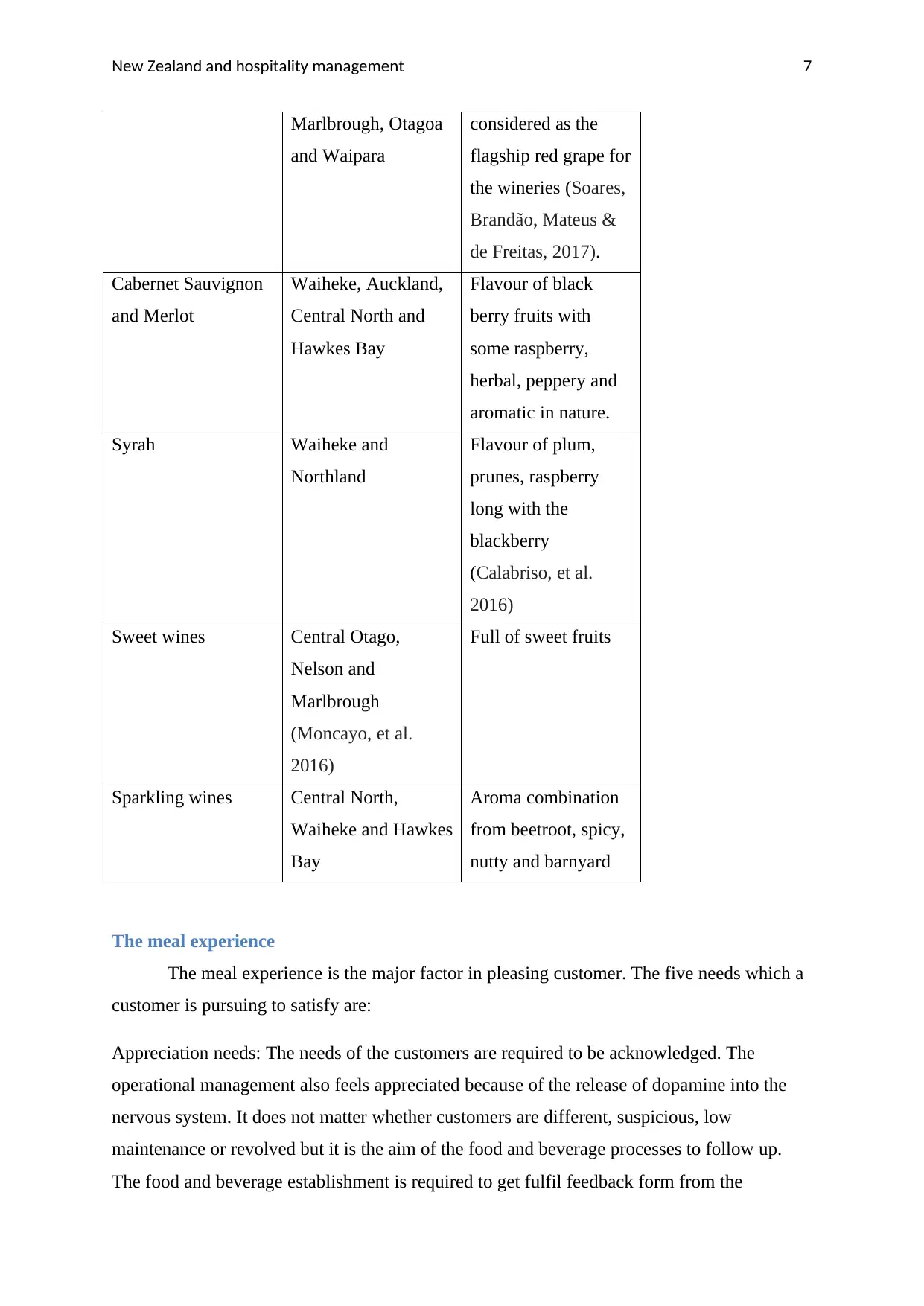
New Zealand and hospitality management 7
Marlbrough, Otagoa
and Waipara
considered as the
flagship red grape for
the wineries (Soares,
Brandão, Mateus &
de Freitas, 2017).
Cabernet Sauvignon
and Merlot
Waiheke, Auckland,
Central North and
Hawkes Bay
Flavour of black
berry fruits with
some raspberry,
herbal, peppery and
aromatic in nature.
Syrah Waiheke and
Northland
Flavour of plum,
prunes, raspberry
long with the
blackberry
(Calabriso, et al.
2016)
Sweet wines Central Otago,
Nelson and
Marlbrough
(Moncayo, et al.
2016)
Full of sweet fruits
Sparkling wines Central North,
Waiheke and Hawkes
Bay
Aroma combination
from beetroot, spicy,
nutty and barnyard
The meal experience
The meal experience is the major factor in pleasing customer. The five needs which a
customer is pursuing to satisfy are:
Appreciation needs: The needs of the customers are required to be acknowledged. The
operational management also feels appreciated because of the release of dopamine into the
nervous system. It does not matter whether customers are different, suspicious, low
maintenance or revolved but it is the aim of the food and beverage processes to follow up.
The food and beverage establishment is required to get fulfil feedback form from the
Marlbrough, Otagoa
and Waipara
considered as the
flagship red grape for
the wineries (Soares,
Brandão, Mateus &
de Freitas, 2017).
Cabernet Sauvignon
and Merlot
Waiheke, Auckland,
Central North and
Hawkes Bay
Flavour of black
berry fruits with
some raspberry,
herbal, peppery and
aromatic in nature.
Syrah Waiheke and
Northland
Flavour of plum,
prunes, raspberry
long with the
blackberry
(Calabriso, et al.
2016)
Sweet wines Central Otago,
Nelson and
Marlbrough
(Moncayo, et al.
2016)
Full of sweet fruits
Sparkling wines Central North,
Waiheke and Hawkes
Bay
Aroma combination
from beetroot, spicy,
nutty and barnyard
The meal experience
The meal experience is the major factor in pleasing customer. The five needs which a
customer is pursuing to satisfy are:
Appreciation needs: The needs of the customers are required to be acknowledged. The
operational management also feels appreciated because of the release of dopamine into the
nervous system. It does not matter whether customers are different, suspicious, low
maintenance or revolved but it is the aim of the food and beverage processes to follow up.
The food and beverage establishment is required to get fulfil feedback form from the
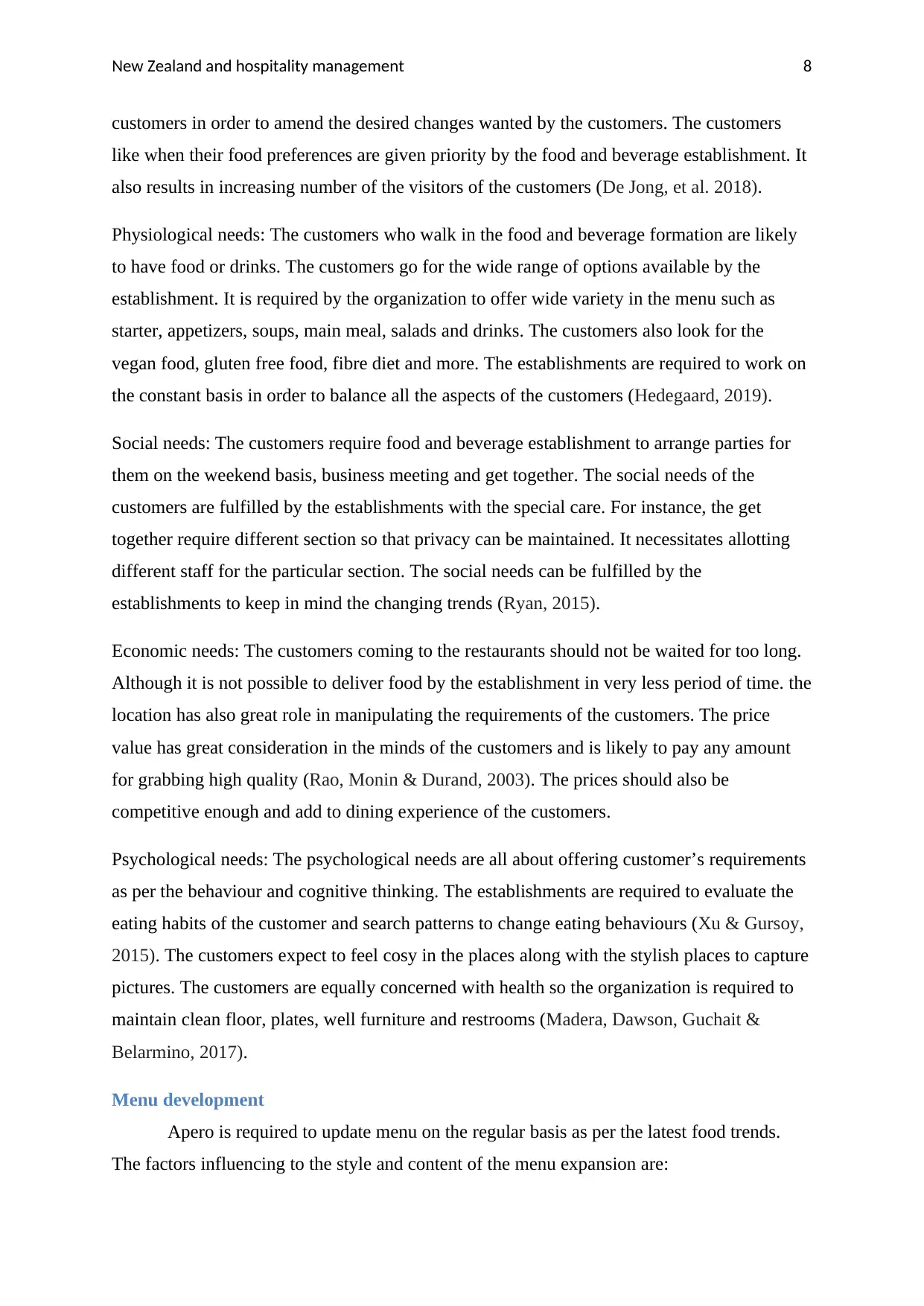
New Zealand and hospitality management 8
customers in order to amend the desired changes wanted by the customers. The customers
like when their food preferences are given priority by the food and beverage establishment. It
also results in increasing number of the visitors of the customers (De Jong, et al. 2018).
Physiological needs: The customers who walk in the food and beverage formation are likely
to have food or drinks. The customers go for the wide range of options available by the
establishment. It is required by the organization to offer wide variety in the menu such as
starter, appetizers, soups, main meal, salads and drinks. The customers also look for the
vegan food, gluten free food, fibre diet and more. The establishments are required to work on
the constant basis in order to balance all the aspects of the customers (Hedegaard, 2019).
Social needs: The customers require food and beverage establishment to arrange parties for
them on the weekend basis, business meeting and get together. The social needs of the
customers are fulfilled by the establishments with the special care. For instance, the get
together require different section so that privacy can be maintained. It necessitates allotting
different staff for the particular section. The social needs can be fulfilled by the
establishments to keep in mind the changing trends (Ryan, 2015).
Economic needs: The customers coming to the restaurants should not be waited for too long.
Although it is not possible to deliver food by the establishment in very less period of time. the
location has also great role in manipulating the requirements of the customers. The price
value has great consideration in the minds of the customers and is likely to pay any amount
for grabbing high quality (Rao, Monin & Durand, 2003). The prices should also be
competitive enough and add to dining experience of the customers.
Psychological needs: The psychological needs are all about offering customer’s requirements
as per the behaviour and cognitive thinking. The establishments are required to evaluate the
eating habits of the customer and search patterns to change eating behaviours (Xu & Gursoy,
2015). The customers expect to feel cosy in the places along with the stylish places to capture
pictures. The customers are equally concerned with health so the organization is required to
maintain clean floor, plates, well furniture and restrooms (Madera, Dawson, Guchait &
Belarmino, 2017).
Menu development
Apero is required to update menu on the regular basis as per the latest food trends.
The factors influencing to the style and content of the menu expansion are:
customers in order to amend the desired changes wanted by the customers. The customers
like when their food preferences are given priority by the food and beverage establishment. It
also results in increasing number of the visitors of the customers (De Jong, et al. 2018).
Physiological needs: The customers who walk in the food and beverage formation are likely
to have food or drinks. The customers go for the wide range of options available by the
establishment. It is required by the organization to offer wide variety in the menu such as
starter, appetizers, soups, main meal, salads and drinks. The customers also look for the
vegan food, gluten free food, fibre diet and more. The establishments are required to work on
the constant basis in order to balance all the aspects of the customers (Hedegaard, 2019).
Social needs: The customers require food and beverage establishment to arrange parties for
them on the weekend basis, business meeting and get together. The social needs of the
customers are fulfilled by the establishments with the special care. For instance, the get
together require different section so that privacy can be maintained. It necessitates allotting
different staff for the particular section. The social needs can be fulfilled by the
establishments to keep in mind the changing trends (Ryan, 2015).
Economic needs: The customers coming to the restaurants should not be waited for too long.
Although it is not possible to deliver food by the establishment in very less period of time. the
location has also great role in manipulating the requirements of the customers. The price
value has great consideration in the minds of the customers and is likely to pay any amount
for grabbing high quality (Rao, Monin & Durand, 2003). The prices should also be
competitive enough and add to dining experience of the customers.
Psychological needs: The psychological needs are all about offering customer’s requirements
as per the behaviour and cognitive thinking. The establishments are required to evaluate the
eating habits of the customer and search patterns to change eating behaviours (Xu & Gursoy,
2015). The customers expect to feel cosy in the places along with the stylish places to capture
pictures. The customers are equally concerned with health so the organization is required to
maintain clean floor, plates, well furniture and restrooms (Madera, Dawson, Guchait &
Belarmino, 2017).
Menu development
Apero is required to update menu on the regular basis as per the latest food trends.
The factors influencing to the style and content of the menu expansion are:
⊘ This is a preview!⊘
Do you want full access?
Subscribe today to unlock all pages.

Trusted by 1+ million students worldwide
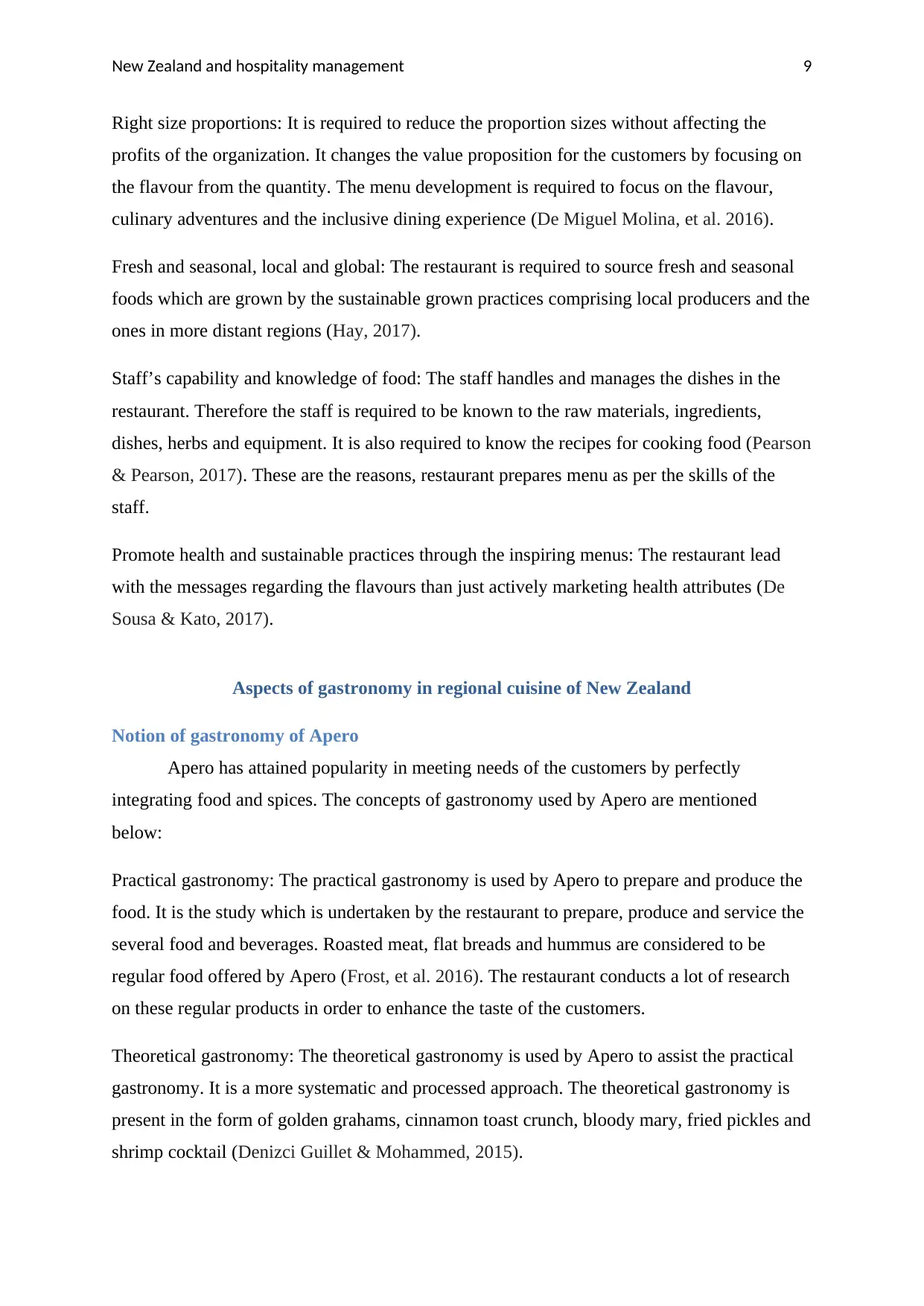
New Zealand and hospitality management 9
Right size proportions: It is required to reduce the proportion sizes without affecting the
profits of the organization. It changes the value proposition for the customers by focusing on
the flavour from the quantity. The menu development is required to focus on the flavour,
culinary adventures and the inclusive dining experience (De Miguel Molina, et al. 2016).
Fresh and seasonal, local and global: The restaurant is required to source fresh and seasonal
foods which are grown by the sustainable grown practices comprising local producers and the
ones in more distant regions (Hay, 2017).
Staff’s capability and knowledge of food: The staff handles and manages the dishes in the
restaurant. Therefore the staff is required to be known to the raw materials, ingredients,
dishes, herbs and equipment. It is also required to know the recipes for cooking food (Pearson
& Pearson, 2017). These are the reasons, restaurant prepares menu as per the skills of the
staff.
Promote health and sustainable practices through the inspiring menus: The restaurant lead
with the messages regarding the flavours than just actively marketing health attributes (De
Sousa & Kato, 2017).
Aspects of gastronomy in regional cuisine of New Zealand
Notion of gastronomy of Apero
Apero has attained popularity in meeting needs of the customers by perfectly
integrating food and spices. The concepts of gastronomy used by Apero are mentioned
below:
Practical gastronomy: The practical gastronomy is used by Apero to prepare and produce the
food. It is the study which is undertaken by the restaurant to prepare, produce and service the
several food and beverages. Roasted meat, flat breads and hummus are considered to be
regular food offered by Apero (Frost, et al. 2016). The restaurant conducts a lot of research
on these regular products in order to enhance the taste of the customers.
Theoretical gastronomy: The theoretical gastronomy is used by Apero to assist the practical
gastronomy. It is a more systematic and processed approach. The theoretical gastronomy is
present in the form of golden grahams, cinnamon toast crunch, bloody mary, fried pickles and
shrimp cocktail (Denizci Guillet & Mohammed, 2015).
Right size proportions: It is required to reduce the proportion sizes without affecting the
profits of the organization. It changes the value proposition for the customers by focusing on
the flavour from the quantity. The menu development is required to focus on the flavour,
culinary adventures and the inclusive dining experience (De Miguel Molina, et al. 2016).
Fresh and seasonal, local and global: The restaurant is required to source fresh and seasonal
foods which are grown by the sustainable grown practices comprising local producers and the
ones in more distant regions (Hay, 2017).
Staff’s capability and knowledge of food: The staff handles and manages the dishes in the
restaurant. Therefore the staff is required to be known to the raw materials, ingredients,
dishes, herbs and equipment. It is also required to know the recipes for cooking food (Pearson
& Pearson, 2017). These are the reasons, restaurant prepares menu as per the skills of the
staff.
Promote health and sustainable practices through the inspiring menus: The restaurant lead
with the messages regarding the flavours than just actively marketing health attributes (De
Sousa & Kato, 2017).
Aspects of gastronomy in regional cuisine of New Zealand
Notion of gastronomy of Apero
Apero has attained popularity in meeting needs of the customers by perfectly
integrating food and spices. The concepts of gastronomy used by Apero are mentioned
below:
Practical gastronomy: The practical gastronomy is used by Apero to prepare and produce the
food. It is the study which is undertaken by the restaurant to prepare, produce and service the
several food and beverages. Roasted meat, flat breads and hummus are considered to be
regular food offered by Apero (Frost, et al. 2016). The restaurant conducts a lot of research
on these regular products in order to enhance the taste of the customers.
Theoretical gastronomy: The theoretical gastronomy is used by Apero to assist the practical
gastronomy. It is a more systematic and processed approach. The theoretical gastronomy is
present in the form of golden grahams, cinnamon toast crunch, bloody mary, fried pickles and
shrimp cocktail (Denizci Guillet & Mohammed, 2015).
Paraphrase This Document
Need a fresh take? Get an instant paraphrase of this document with our AI Paraphraser
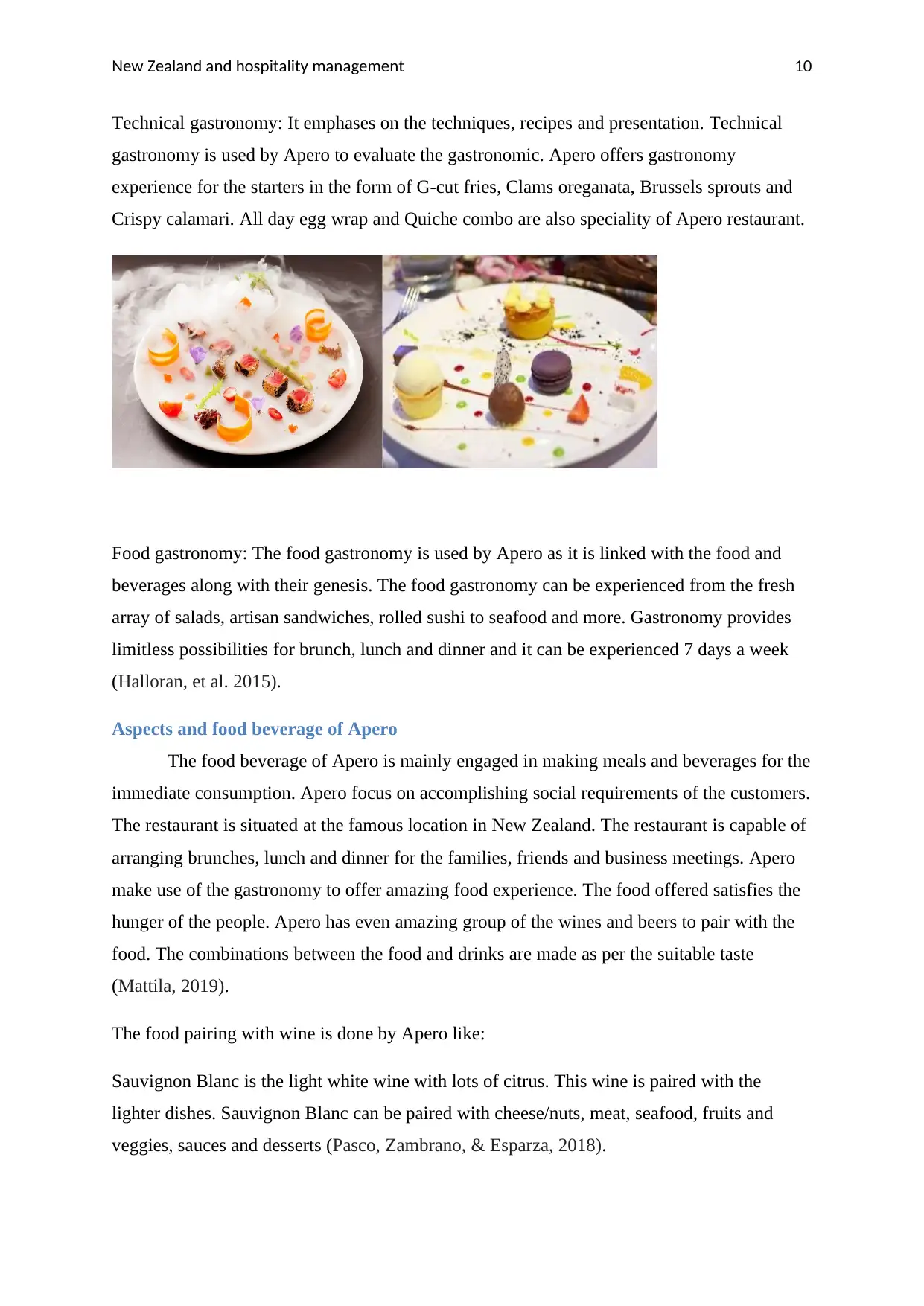
New Zealand and hospitality management 10
Technical gastronomy: It emphases on the techniques, recipes and presentation. Technical
gastronomy is used by Apero to evaluate the gastronomic. Apero offers gastronomy
experience for the starters in the form of G-cut fries, Clams oreganata, Brussels sprouts and
Crispy calamari. All day egg wrap and Quiche combo are also speciality of Apero restaurant.
Food gastronomy: The food gastronomy is used by Apero as it is linked with the food and
beverages along with their genesis. The food gastronomy can be experienced from the fresh
array of salads, artisan sandwiches, rolled sushi to seafood and more. Gastronomy provides
limitless possibilities for brunch, lunch and dinner and it can be experienced 7 days a week
(Halloran, et al. 2015).
Aspects and food beverage of Apero
The food beverage of Apero is mainly engaged in making meals and beverages for the
immediate consumption. Apero focus on accomplishing social requirements of the customers.
The restaurant is situated at the famous location in New Zealand. The restaurant is capable of
arranging brunches, lunch and dinner for the families, friends and business meetings. Apero
make use of the gastronomy to offer amazing food experience. The food offered satisfies the
hunger of the people. Apero has even amazing group of the wines and beers to pair with the
food. The combinations between the food and drinks are made as per the suitable taste
(Mattila, 2019).
The food pairing with wine is done by Apero like:
Sauvignon Blanc is the light white wine with lots of citrus. This wine is paired with the
lighter dishes. Sauvignon Blanc can be paired with cheese/nuts, meat, seafood, fruits and
veggies, sauces and desserts (Pasco, Zambrano, & Esparza, 2018).
Technical gastronomy: It emphases on the techniques, recipes and presentation. Technical
gastronomy is used by Apero to evaluate the gastronomic. Apero offers gastronomy
experience for the starters in the form of G-cut fries, Clams oreganata, Brussels sprouts and
Crispy calamari. All day egg wrap and Quiche combo are also speciality of Apero restaurant.
Food gastronomy: The food gastronomy is used by Apero as it is linked with the food and
beverages along with their genesis. The food gastronomy can be experienced from the fresh
array of salads, artisan sandwiches, rolled sushi to seafood and more. Gastronomy provides
limitless possibilities for brunch, lunch and dinner and it can be experienced 7 days a week
(Halloran, et al. 2015).
Aspects and food beverage of Apero
The food beverage of Apero is mainly engaged in making meals and beverages for the
immediate consumption. Apero focus on accomplishing social requirements of the customers.
The restaurant is situated at the famous location in New Zealand. The restaurant is capable of
arranging brunches, lunch and dinner for the families, friends and business meetings. Apero
make use of the gastronomy to offer amazing food experience. The food offered satisfies the
hunger of the people. Apero has even amazing group of the wines and beers to pair with the
food. The combinations between the food and drinks are made as per the suitable taste
(Mattila, 2019).
The food pairing with wine is done by Apero like:
Sauvignon Blanc is the light white wine with lots of citrus. This wine is paired with the
lighter dishes. Sauvignon Blanc can be paired with cheese/nuts, meat, seafood, fruits and
veggies, sauces and desserts (Pasco, Zambrano, & Esparza, 2018).
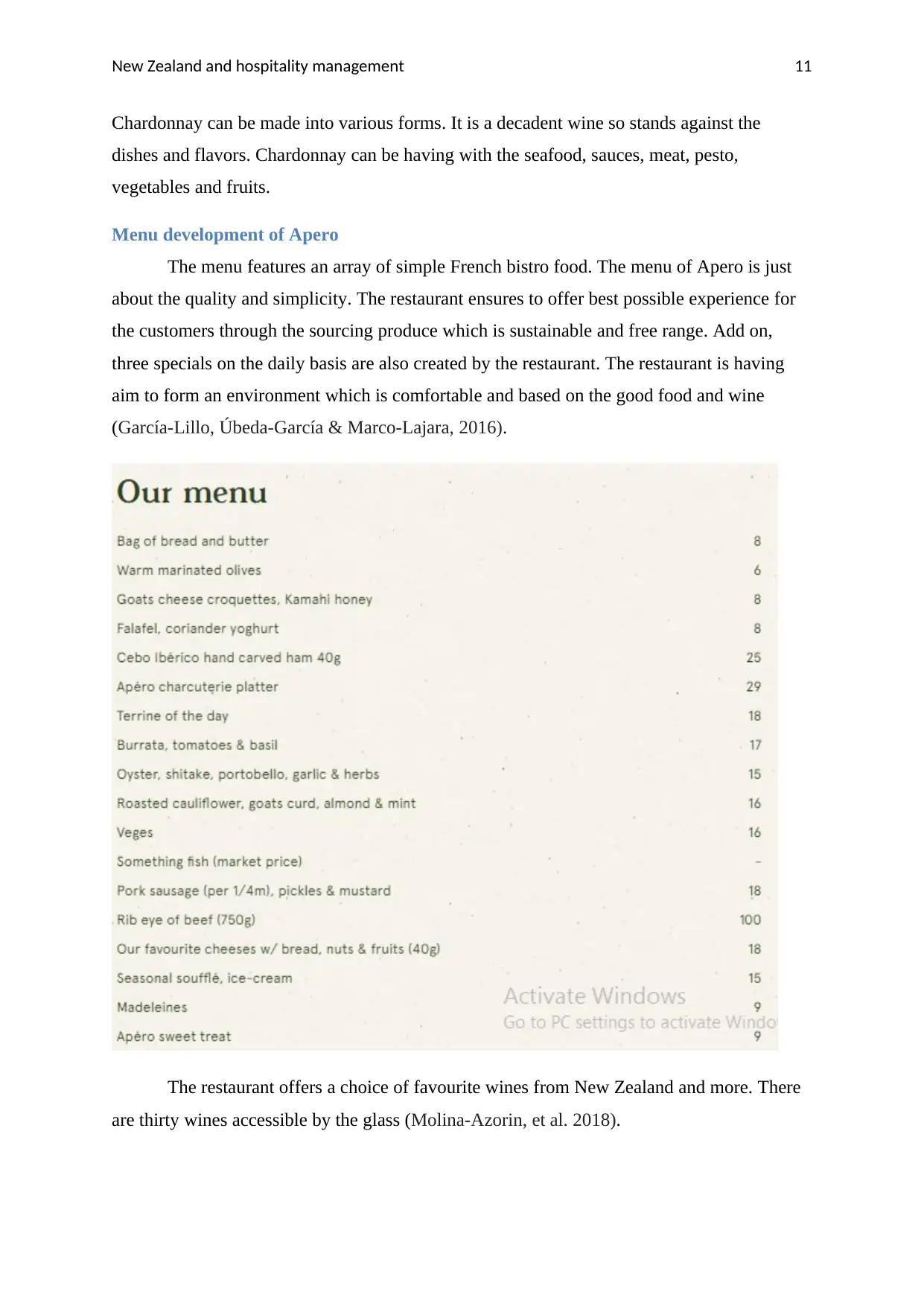
New Zealand and hospitality management 11
Chardonnay can be made into various forms. It is a decadent wine so stands against the
dishes and flavors. Chardonnay can be having with the seafood, sauces, meat, pesto,
vegetables and fruits.
Menu development of Apero
The menu features an array of simple French bistro food. The menu of Apero is just
about the quality and simplicity. The restaurant ensures to offer best possible experience for
the customers through the sourcing produce which is sustainable and free range. Add on,
three specials on the daily basis are also created by the restaurant. The restaurant is having
aim to form an environment which is comfortable and based on the good food and wine
(García-Lillo, Úbeda-García & Marco-Lajara, 2016).
The restaurant offers a choice of favourite wines from New Zealand and more. There
are thirty wines accessible by the glass (Molina-Azorin, et al. 2018).
Chardonnay can be made into various forms. It is a decadent wine so stands against the
dishes and flavors. Chardonnay can be having with the seafood, sauces, meat, pesto,
vegetables and fruits.
Menu development of Apero
The menu features an array of simple French bistro food. The menu of Apero is just
about the quality and simplicity. The restaurant ensures to offer best possible experience for
the customers through the sourcing produce which is sustainable and free range. Add on,
three specials on the daily basis are also created by the restaurant. The restaurant is having
aim to form an environment which is comfortable and based on the good food and wine
(García-Lillo, Úbeda-García & Marco-Lajara, 2016).
The restaurant offers a choice of favourite wines from New Zealand and more. There
are thirty wines accessible by the glass (Molina-Azorin, et al. 2018).
⊘ This is a preview!⊘
Do you want full access?
Subscribe today to unlock all pages.

Trusted by 1+ million students worldwide
1 out of 20
Related Documents
Your All-in-One AI-Powered Toolkit for Academic Success.
+13062052269
info@desklib.com
Available 24*7 on WhatsApp / Email
![[object Object]](/_next/static/media/star-bottom.7253800d.svg)
Unlock your academic potential
Copyright © 2020–2025 A2Z Services. All Rights Reserved. Developed and managed by ZUCOL.





